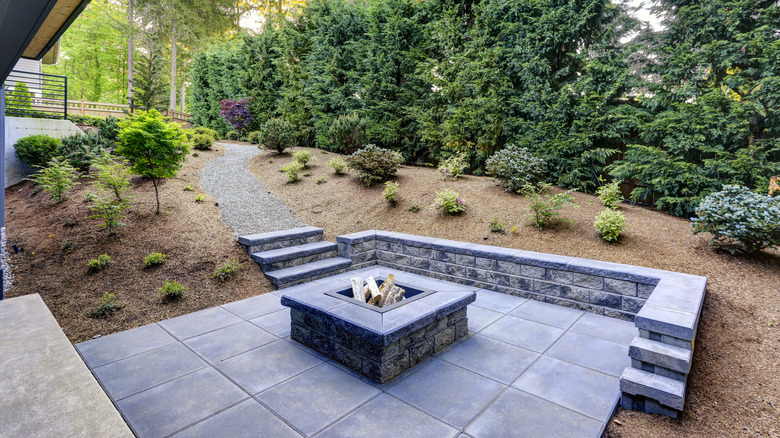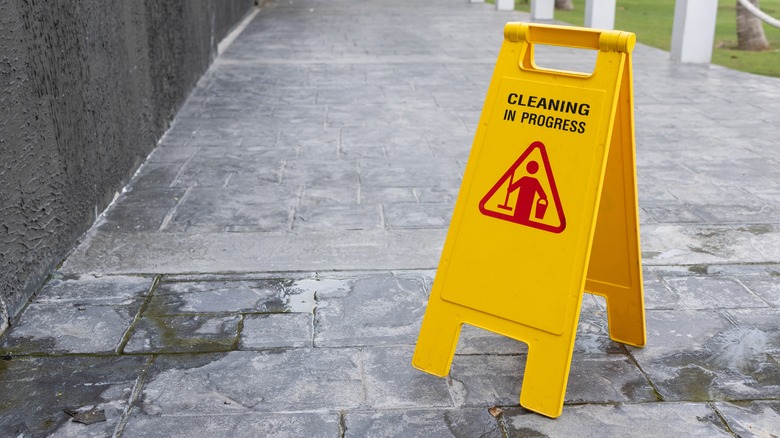Slate Tiles Are A Solid Choice For Your Patio Floor (But Look Out For One Issue)
We may receive a commission on purchases made from links.
Knowing what to pave your patio with is ... challenging, to put it mildly. Once you've worked out how much money you're willing to spend and measured the area, you have to consider everything from durability and matching existing decor to longevity and weatherproofness. What's more, there's a seemingly endless selection of different types of tiles you can use for your outdoor patio. If your budget's on the higher side, you might be considering the heavyweight of outdoor paving: slate. Here's the problem with this undeniably attractive material: water — especially acid rain (yes, that's not just a phenomenon from the 1980s) and hard water — can mar the tiles' naturally tough yet porous surface.
You've already thought through the big differences to consider when choosing between a patio and deck and settled on the former — in slate. But exactly what type of slate did you choose? No matter where it's from, all slate is a type of natural stone (or, more precisely, metamorphic rock) dug up from the earth. North American-produced slate comes from quarries in Vermont, Pennsylvania, Virginia, and New York. Other large slate producers worldwide include Spain, Portugal, Italy, Germany, Brazil, and, more recently, China. It's available in various naturally occurring colors: gray to green to red, depending on where it's quarried. Since porosity is responsible for most slate water staining issues, choosing a less porous slate — like imported (and, notably, very expensive) ultra-dense Welsh slate or local Virgina slate — will mean fewer water-related stains.
Water stain causes and cleaning tips
While some types of slate tile are tougher than others, they're all susceptible to some degree of efflorescence — that weird white powdery stuff that covers once-pristine tiles. It's not serious, but it nevertheless looks terrible. It's caused by hard water mineral deposits or water lifting the salt from your slate. You might notice it more after a period of stormy weather. Discolored water dripping onto your patio — say, rain running through leaf-clogged guttering and tumbling out a crack in said plumbing — and salt or chemical-filled water from ponds and swimming pools can stain the porous stone, too. Finally, if you mop your patio flooring often, using too much water can leave unsightly water spots after the tiles have dried. The solution to this particular problem is easy: use a just-damp, not a saturated mop head.
Removing stains caused by hard or discolored water or efflorescence requires a little more graft. Avoid highly acidic or alkaline cleaners or cleaners with harsh chemicals. Ruining your pricey slate tiles when you meant to repair them is a terrible enough consequence, but perhaps worse is those chemicals leaching into the surrounding garden beds and lawns. If you're spot-cleaning water stains, mix vinegar or hydrogen peroxide with water in equal amounts — ideally, in a spray bottle, but any closed container will do. Spray or pour the liquid onto the stains and wait at least ten minutes. Wipe away with a sponge or soft cloth — again, don't use anything rough.
Long-term slate maintenance
You can safely use a pressure washer on outdoor slate tiles. However, the pressure shouldn't exceed 1,000 PSI, and you should hold the wand at least 12 inches above the tiles. Otherwise, you risk flaking the stone. For extra stain-removing power, apply an eco-friendly slate-safe cleaner across the entire patio before pressure washing. For example, you can get an Eco Guard Outdoor Multi-Surface Cleaner in a 128-ounce bottle for $76.60 at Walmart.
By now, you probably feel empowered knowing the best way to clean the slate. Rightly so! Your hard work has freed your patio of stains, at least in the short term. We hate to be the bearer of frustrating news, but long-term slate tile care matters just as much. For one, if you never sealed your outdoor slate floor or it hasn't been re-done in a while, consider getting it done — or DIYing it if you're handy. Sealing improves the natural waterproofness of the stone, repelling water before it even has a chance to stain. Expert advice is to apply an impregnating sealer over a topical sealer; the former soaks into your slate and lasts far longer, making it more cost and time-effective. My Stone Care sells 1-gallon bottles of Stone Pro Porous Pro Impregnator for $156. Alternatively, applying a specialist slate oil can seal the slate tiles. It seems to be an option that's more popular in the U.K. than in the U.S., but Amazon has 250 milliliter (8.4 fluid ounce) bottles of Tableau Slate Oil for $25.88.

